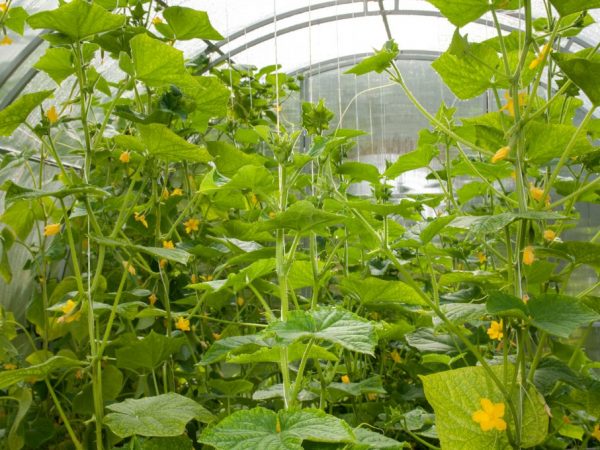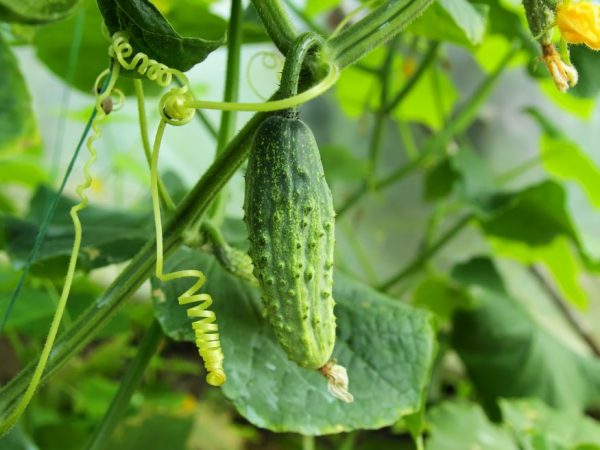Suitable varieties of cucumber for a polycarbonate greenhouse
Many summer residents throughout the year try to grow vegetables in the off-season. Basically, to get ripe and healthy cucumbers, greenhouses are used from quality materials such as polycarbonate. To get a bountiful harvest, you need to know what varieties of cucumbers are available for a polycarbonate greenhouse. A correctly selected variety of cucumbers in a polycarbonate greenhouse will yield a bountiful harvest, as well as beautiful and healthy fruits.

Suitable varieties of cucumber for a polycarbonate greenhouse
Winter-spring varieties
Thanks to numerous reviews and research by specialists, the best winter-spring varieties of cucumbers for polycarbonate greenhouses were selected. To harvest early fruits in spring, it is best to plan seed sowing in February.
- Blagovest 1. Blagovest cucumbers are self-pollinated varieties that have large bushes with many lashes. Self-pollinated types of cucumbers are less likely to be affected by powdery mildew and other common plant diseases. The fruits of the Blagovest variety 1 have an oblong shape, covered with a pimply skin, and weigh up to 85 grams. Such cucumbers are great for salads as fresh fruits, and are also used for making marinades and pickles.
- Moscow greenhouse f1. F1 greenhouse varieties are the earliest, best self-pollinated cucumber varieties for polycarbonate greenhouses. This type of cucumber belongs to the type of plant where the fruit lacks seeds in the pulp. Greenhouse hybrid F1 is famous for its delicious fruits, each of which has a length of about 40 cm. However, these cucumbers are only suitable for fresh consumption; cucumbers of this type are usually not used for making pickles and pickles.
- The F1 relay is a pollinated species with an average maturation rate. This type of fruit is most often used as an ingredient in salads.
- Manual F1 is another medium-ripening pollinated species that, when fresh, is only suitable for making salads.
In order to determine in practice which species are the best and the earliest for polycarbonate greenhouses, it is recommended to plant several species at once, having previously noted where which variety of cucumbers is.
Spring-summer varieties
Among the various types of cucumbers, the seeds of which are suitable for growing in greenhouses in the summer, only two common hybrids are clearly successful among gardeners:
- Zozulya F1 is the most popular type of cucumber, with flowers belonging exclusively to the female type and with large fruits. In the suburbs and central Russia, the f1 zozul variety grows well.
- April F1 is one of the tastiest hybrids of its kind with fruits weighing up to 300 grams.
In addition to the high yield, this type of plant is resistant to most common diseases.However, there is one important rule to keep in mind: in order to achieve the best yield, you should choose varieties with an average degree of branch density.
Summer-autumn varieties
For growing cucumber seeds in artificially created favorable conditions, from July to November, the following hybrids are most preferable:
- Maryina Roshcha F1 is the best option for getting a quick harvest. Variety with good ripening rate. The fruits are formed without the need for pollination. This variety perfectly adapts to various growing conditions. Fruits of the type Maryina Grove f1, have large pimples, can be excellent for the preparation of various marinades and pickles.
- Anyuta F1 is a gherkin with small fruits and pimpled skin, well suited for making marinades and pickles.
Hybrids Maryina Roshcha and Anyuta f1 are the best varieties of cucumbers for polycarbonate greenhouses in summer and autumn. Their popularity among gardeners, such species received due to their taste characteristics and relatively good unpretentiousness in the growing process. Since the fruits of cucumbers accumulate a lot of sugar during the summer-autumn period, they are often used for making marinades. In this case, clearly braided hybrids are considered the best cucumber hybrids that are suitable for indoor cultivation with polycarbonate glazing.
Harvest varieties

The choice of varieties is great
- Annushka F1 is the best variety, suitable for maturation in polycarbonate rooms. However, the Annushka variety is also well suited for growing without the use of insulated rooms. Annushka differs from similar species in that it actively matures and does not require special care conditions. These cucumbers are well consumed unprocessed and are also suitable for making pickles and marinades.
- The bouquet is gherkins ripening within a month after planting the seeds in the ground. The bouquet is a variety that is resistant to most common plant diseases.
- Gladiator is an unpretentious species, has an average ripening period. With proper care, the yield is good, the fruits are strong and healthy.
- Azbuka is a good-yielding gherkin with fruits of a sweetish taste, which is suitable for making pickled cucumbers.
- Green Wave is a versatile early maturing hybrid capable of producing a good harvest, both indoors and outdoors.
- Goosebump F1 is one of the few varieties that is unable to accumulate alkaloids that cause bitterness.
- A boy with a finger - the variety perfectly adapts to greenhouse cultivation. This type of cucumber is resistant to common pests and diseases.
- Baloven F1 is a fast ripening species with fruits without a bitter aftertaste.
- Siberian garland F1 is a species that has a palm among varieties grown in greenhouses with a polycarbonate surface. The harvest of these cucumbers can be harvested until the onset of frost.
Choosing the right seeds
Today, on the seed market, there is a very large amount of counterfeit, which is not always possible to recognize. Often, they try to sell seeds simply packaged in transparent bags without information about the manufacturer, country of origin, expiration date and other important information. The origin of such products can only be guessed at.
Regardless of which variety of cucumbers is most preferable, an important rule should be observed: it is recommended to buy seeds only in branded packages with special manufacturer's markings.
Only an official large producer can guarantee the high quality of the seeds and their compliance with the declared variety.This precaution will help to avoid fakes, and will make it possible to grow and harvest a good harvest of ripe high-quality cucumbers, which will delight with its taste and benefits throughout the year.
Exotic varieties
There are varieties of cucumbers, the appearance of which, as well as taste, differ significantly from those familiar to most Russian consumers.
- The most common type of exotic cucumber for polycarbonate greenhouses is the Bride variety. White fruits of this species are famous for their excellent taste and aroma. Bride - great for pickling and eating fresh fruits.
- Beijing. The fruits of this Chinese hybrid, despite not the most attractive appearance and irregular shape, have good taste characteristics. This species is able to bear fruit even in a cold greenhouse. However, it should be borne in mind that when grown in a warmed room, you need to select varieties in accordance with the region of their growth and climatic predisposition.
- Lemon is a cucumber with yellow and oval fruits. This variety has a fairly high yield, which can reach up to 8 kg per bush.
- The Armenian cucumber is an exotic vegetable, the fruits of which look like zucchini, have a juicy crunchy pulp and a melon aroma.
- Rough melotria is one of the most popular ornamental plants with fruits similar to miniature watermelons.
- Golden Dragon Egg is a beautiful name for an exotic Chinese cucumber with small yellow fruits that have fruity flavors.
Useful tips for gardeners
In the course of studying the demand for varieties of various cucumbers in a polycarbonate greenhouse, among consumers from different countries, an interesting detail was noticed: among Russian consumers, pimpled species are most popular, since they are considered national vegetables. But the inhabitants of European countries prefer fruits with a smooth peel. Regardless of which type of cucumber you choose, it is important to properly care for the plantings. Among the different types of cucumbers and pimply and not, there may be representatives, the fruits of which have a taste of bitterness of varying degrees of severity.
Where does the bitterness in cucumbers come from? It's simple - at high temperatures and low watering, an alkaloid is formed in the fruits, which gives the cucumbers a bitter taste.
Also, the composition of the soil affects the taste of cucumbers, so it makes sense to plant new types of cucumbers on pre-prepared soil. Since greenhouse conditions are excellent not only for growing cucumbers, but also a favorable environment for the life of various harmful microorganisms, there is a risk of exposing early seedlings to various diseases. To save the harvest, the soil must be disinfected with chlorine; copper sulfate can also cope with this task.

